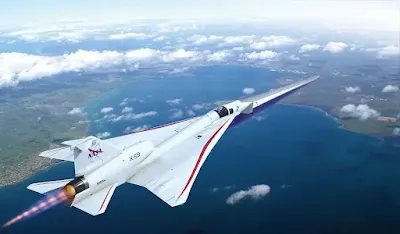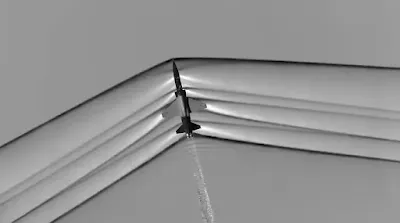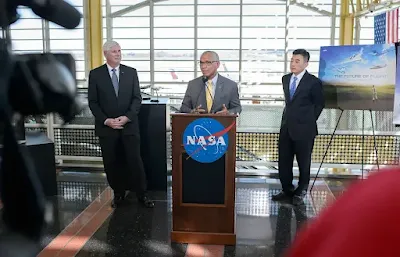.webp) |
| Credits to NASA |
History of the Program of X Planes
As
per the information that I have collected from NASA’s
official site. According to that, the U.S. X-Plane Program, originating
with the X-1's groundbreaking sound barrier breakthrough in 1947, has made over
30 major research designs. Beyond rocket-powered aircraft, it has got a wide range
of experimental vehicles, achieving milestones like breaking the sound barrier,
implementing variable-sweep-wing technology, and reaching altitudes exceeding
90,000 meters.
Credits to NASA
The
testing of these plane majorly occurred at Edwards Air Force Base, with other
sites across the U.S. Despite technical glitches, the program boasts notable
safety achievements, with few accidents and no civilian property damage or
fatalities. A significant member, the X-33, continues the program's legacy,
exploring reusable spaceplane technology. Overall, the X-Plane Program has
played an important role in advancing aerospace research and development.
Another
such a notable plane was the Concorde, a joint project between France and the
United Kingdom, made its maiden flight in 1969 and became synonymous with
luxury and speed. Operating commercially from 1976 to 2003, the Concorde could
travel at speeds exceeding Mach 2 (twice the speed of sound) and significantly
reduced travel times across the Atlantic.
Challenges of Supersonic Flight and Sonic Booms: Supersonic flight poses challenges primarily due to the creation of sonic booms. When an object travels through the air faster than the speed of sound, it generates shockwaves that combine to form a sonic boom. These booms can be troublemaking and have limited the capability of overland supersonic travels, thus have created restrictions to the use of this planes and public concerns about noise pollution.
What are the objectives of QueSST Mission ?
The major objective of NASA is to lift the ban that is imposed on supersonic
flight over land by reducing the disruptive nature of sonic boom associated
with such travel. Sonic booms, generated when shock waves from an object
traveling faster than the speed of sound merge, produce a loud sound, roughly
110 decibels, which is equivalent to an explosion or thunderclap or comparable
to a gun shot. Whereas the average human pain threshold is only 70 decibels.
Now you can see where this all is going! And that’s is the reason of why NASA is
working on this project, to lift ban from commercial supersonic flight and thus
make travel efficient.
Credits to NASA
What is the approach that NASA is following ?
The X-59 QueSST (Quiet Supersonic Technology) aircraft, developed by NASA, addresses the sonic boom challenge through new innovative design and technology. The aircraft features a unique shape designed to manage shockwaves more effectively, spreading them out and reducing their intensity. This design aims to create a quieter, more acceptable sonic thump (a reduced version of sonic boom), making overland supersonic travel a possibility without causing significant disturbance to communities below.
How’s NASA making all this possible ?
So,
this one of the question that will come in everyone’s mind of how are they even
achieving all of this. Well from reference no. 5, I got the following
information — The X-59 Quiet Supersonic Technology (QueSST) airplane has a unique
design developed by NASA themselves, which seeks to efficiently reduce the
intensity of the sonic boom and making sonic boom to turn into a softer sonic
"thump." What’s a sonic thump ? Well, we can say that the slightly
quieter version of a sonic boom is called a sonic thump. Engineers from NASA's
Commercial Supersonic Technology (CST) project utilized a small-scale X-59
model in the NASA Glenn 8- by 6-foot Supersonic Wind Tunnel. This testing aimed
to visualize and validate boom-reducing technology and predict sonic thumps accurately.
The model, subjected to weeks of testing, generated shock waves captured by
specialized cameras and a sensor array. Schlieren images (Schlieren images is a
technique used to visualize variations in the air density) from the cameras
displayed the shock waves and their positions as air passed around the model,
while the sensor provided detailed measurements of shock strength. Encouragingly,
results aligned with earlier computer models, affirming the feasibility of
quieter supersonic flight..webp)
Credits to NASA
Here,
schlieren imagery and pressure measurement are really very important for NASA.
For them to compare wind tunnel data with computer modelling, improving their
understandings and predictions about sonic thumps during X-59 flights. John
Wolter, the lead researcher on the X-59 sonic boom wind tunnel test, emphasized
the goal of showcasing that the X-59 can reduce sonic booms to quieter
"sonic thumps." This initiative aims to provide regulators with noise
and community response data, potentially leading to new rules for overland
supersonic flight. The successful test affirms not only quieter aircraft design
but also the precision of tools for predicting future aircraft noise.
Credits to NASA
What did NASA say about X-59 in the public debut?
NASA
and Lockheed Martin officially presented the X-59 quiet supersonic aircraft, a
groundbreaking project aiming to transform air travel on 12th of
January, 2024. On that occasion, NASA Deputy Administrator Pam Melroy highlighted
the achievements of X-59, stating, “NASA’s X-59 will help change the way we
travel, bringing us closer together in much less time.”
Credits to NASA
The
X-59, part of NASA’s QueSST mission, seeks to gather data challenging
regulations prohibiting supersonic
flight over land due to disruptive sonic booms. Expected to fly at 1.4 times
the speed of sound (925 mph or 1489 kph), the X-59's design enables quieter
sonic thumps. Bob Pearce, associate administrator for aeronautics research,
highlighted NASA's intent to share data and technology generated from the
mission, demonstrating the possibility of quiet commercial supersonic travel.
Following
rollout, the QueSST team will proceed with integrated systems testing, engine
runs, and taxi testing before the X-59's first flight later this year. Flight
tests will be conducted at Lockheed Martin Skunk Works before transferring to
NASA’s Armstrong Flight Research Centre. Once tests are complete, NASA will fly
the X-59 over selected U.S. cities, collecting data on the sound and public
perception. The 99.7 feet long, 29.5 feet wide X-59 features a unique design to
minimize shock waves and sonic booms, with an innovative external Vision System
replacing forward-facing windows. The X-59 represents a leap toward quiet
supersonic flight, providing valuable insights for future generations of
aircraft.
What is the Future of Supersonic Travel ?
As said earlier the main goal of NASA here, is to develop and deploy an aircraft which would produce less than 75 decibels of sound wave intensity. Thus, will make supersonic planes legal to fly over lands and thud reducing noise pollution done by them. The success of NASA's X-59 QueSST project will definitely reshape the future of supersonic travel. This breakthrough may also drive technological innovations, create economic opportunities, and position the U.S. as a leader in advanced aerospace development. Ultimately, the X-59's impact extends beyond noise reduction, presenting the potential for a global transformation in high-speed air transportation.
References: At the end of this article, I would like to present you all with the list of websites I would like to give credits. I would appreciate if you all visited them as they contain a lot of information that I didn’t mention here :
- NASA,
Lockheed Martin reveal X-59 Quiet Supersonic Aircraft - NASA. (n.d.). NASA. https://www.nasa.gov/news-release/nasa-lockheed-martin-reveal-x-59-quiet-supersonic-aircraft/
- NASA. (2024,
January 17). Quesst. https://www.nasa.gov/mission/QueSST/
- Wikipedia contributors. (2024b, January 16). Lockheed Martin X-59 Quesst. Wikipedia. https://en.wikipedia.org/wiki/Lockheed_Martin_X-59_Quesst
- NASA. (2023,
July 26). New supersonic technology designed to reduce sonic booms. NASA.
https://www.nasa.gov/centers-and-facilities/armstrong/new-supersonic-technology-designed-to-reduce-sonic-booms/
- Welch, N. (2023, August 31). Taming the BOOM - NASA. NASA. https://www.nasa.gov/centers-and-facilities/armstrong/taming-the-boom/
THANK YOU !!! FOR THE READING TILL LAST AND I HOPE YOU ALL LIKED IT & DON'T FORGET TO SHARE THE ARTICLE!!!
